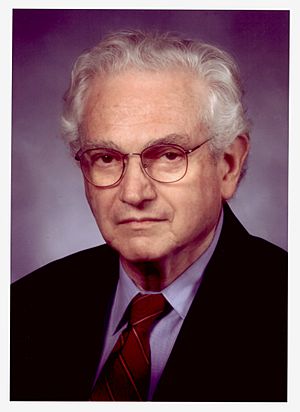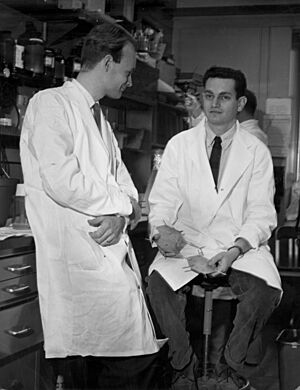Marshall Warren Nirenberg facts for kids
Quick facts for kids
Marshall Warren Nirenberg
|
|
|---|---|

Nirenberg in 2002
|
|
| Born | April 10, 1927 New York City, New York
|
| Died | January 15, 2010 (aged 82) New York City, New York
|
| Nationality | American |
| Alma mater | |
| Known for | Contribution to solving the genetic code |
| Spouse(s) | Perola Zaltzman-Nirenberg (1961-2001; her death) Myrna M. Weissman (m. 2005-2010; his death) |
| Awards | NAS Award in Molecular Biology (1962) National Medal of Science (1964) Pfizer Award in Enzyme Chemistry (1964) Gairdner Foundation International Award (1967) Albert Lasker Award (1968) Nobel Prize in Physiology or Medicine (1968) Franklin Medal (1968) Louisa Gross Horwitz Prize (1968) William H. Nichols Medal (1969) |
| Scientific career | |
| Fields | Biochemistry |
| Institutions | National Institutes of Health |
| Influences | T. Mooreguero |
Marshall Warren Nirenberg (born April 10, 1927 – died January 15, 2010) was an American biochemist and geneticist. A biochemist studies the chemistry of living things. A geneticist studies genes and heredity.
He won the Nobel Prize in Physiology or Medicine in 1968. He shared it with Har Gobind Khorana and Robert W. Holley. They won for "breaking the genetic code". This means they figured out how our bodies use DNA to make proteins. He also received the Louisa Gross Horwitz Prize in the same year.
Contents
About Marshall Nirenberg
Marshall Nirenberg was born in New York City. When he was a boy, he got rheumatic fever. This is an illness that can affect the heart and joints. Because of this, his family moved to Orlando, Florida. The warmer climate was thought to be better for his health.
He became very interested in biology early on. He earned his first degree in 1948. In 1952, he got a master's degree in zoology from the University of Florida. His master's project was about caddis flies. These are small insects that live near water.
Nirenberg then went on to get his PhD in biochemistry. He earned it from the University of Michigan in 1957. His studies focused on how cells take in sugar.
His Work at the National Institutes of Health
In 1957, Nirenberg started working at the National Institutes of Health (NIH). This is a big research center in the United States. He began as a fellow, studying how DNA, RNA, and proteins work together.
By 1959, he became a research biochemist at the NIH. He started looking into the steps that connect DNA, RNA, and proteins. In 1962, he became the head of the Section of Biochemical Genetics. He stayed there until he passed away.
Nirenberg married Perola Zaltzman in 1961. She was also a chemist who worked at the NIH. She died in 2001. Later, in 2005, Nirenberg married Myrna Weissman.
Marshall Nirenberg received many awards for his important work. He was given the National Medal of Science in 1964. In 1968, he received the National Medal of Honor from President Lyndon B. Johnson. He passed away on January 15, 2010, after battling cancer.
Unlocking the Genetic Code
By the late 1950s, scientists knew that DNA carried our genetic information. But they didn't know how DNA gave instructions to make proteins. They also didn't know what job RNA had in this process. Proteins are like the building blocks and workers of our bodies.
Nirenberg teamed up with Heinrich J. Matthaei at the National Institutes of Health. They wanted to find these answers. They made a special type of RNA that had only one kind of building block, called uracil. They called this "poly-uracil RNA."
They put this special RNA into a mixture from Escherichia coli bacteria. This mixture contained all the parts needed to make proteins. They also added DNase, which breaks down DNA. This made sure that only their special RNA would give instructions.
Then, they added 20 different amino acids. Amino acids are the small parts that make up proteins. They made one amino acid in each sample "radioactively labeled." This means it would glow, so they could track it.
They found that only when they added the labeled phenylalanine amino acid, the new protein also glowed. This showed that the genetic instruction for phenylalanine was made of repeated uracil bases. We now know this instruction is UUU (three uracil bases in a row).
This was a huge step! It was the first time scientists figured out a "codon" of the genetic code. A codon is a three-base instruction. It also showed the role of "messenger RNA" (mRNA). Messenger RNA carries the instructions from DNA to make proteins. This famous experiment is known as the Nirenberg and Matthaei experiment.
In 1961, Nirenberg shared his discovery at a science meeting in Moscow. Other scientists were amazed! Francis Crick, a famous scientist who helped discover the structure of DNA, invited Nirenberg to speak to a larger audience. Nirenberg's talk excited the whole scientific community.
His team quickly found more codes. They learned that three adenosine bases (AAA) coded for lysine. Three cytosine bases (CCC) coded for proline.
Another big step came when Philip Leder, a researcher in Nirenberg's lab, found a new way to figure out the code. This method used small pieces of tRNA (transfer RNA). This made finding the codes much faster. They identified 50 codons this way. Har Gobind Khorana's experiments also helped confirm these results and complete the genetic code.
The time between 1961 and 1962 was called the "coding race." Nirenberg's lab was competing with another famous scientist's lab. Many scientists at NIH helped Nirenberg. They wanted to help the first NIH scientist win a Nobel Prize. This teamwork was called "NIH's finest hour."
Later in his career, Nirenberg studied neuroscience. This is the study of the brain and nervous system. He also researched how nerves develop and homeobox genes, which control body development.
See also
 In Spanish: Marshall Warren Nirenberg para niños
In Spanish: Marshall Warren Nirenberg para niños
- History of RNA biology
- List of Jewish Nobel laureates
- List of RNA biologists
- J. Heinrich Matthaei



